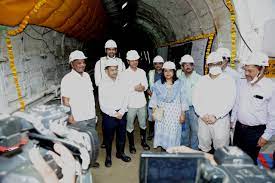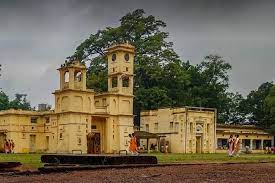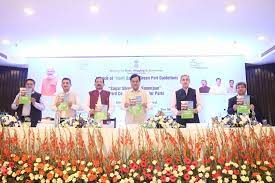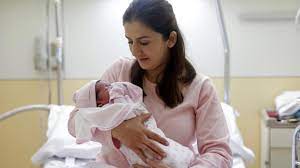Today’s Current Affairs: 12th May 2023 for UPSC IAS exams, State PSC exams, SSC CGL, State SSC, RRB, Railways, Banking Exam & IBPS, etc
Table of Contents
Chheligada Irrigation Project:

5T(Team work, technology, transparency, transformation and time ) secretary-cum-secretary to the Odisha Chief Minister recently directed officials to begin construction of the multipurpose irrigation project at Chheligada.
- Chheligada Irrigation Project is a multipurpose medium project being undertaken across river Badjhore, a tributary of river Vansadhara near the village Chheligada in the Gajapati District of Odisha.
- The Project envisages the construction of a 250m long & 30m high dam across the river Badjhore with a central spillway.
- After this Project, 5201 hectares metres water can be preserved and water can be supplied for irrigation of 5760 hectares of land in Ganjam and 500 hectares of land in Gajapati districts.
- This Project will also provide drinking water to Brahampur City.
- Additionally, 36 MW of electricity can be produced through a mini hydel project in three places Shiali Loti, Kankata and Dekili in the Gajapati district.
Visva Bharati University:

The Calcutta High Court granted interim relief to Nobel laureate Amartya Sen recently by prohibiting Visva Bharati University from acting on its decision asking him to relinquish a portion of his land at his property at Shantiniketan.
- Viswa Bharati University is one of India’s major Central Government funded autonomous Universitylocated in Santiniketan, West Bengal.
- It is well-known as a distinguished centre for Visual Arts practice and research in India.
- The University was established in 1921 by Nobel Prize Laureate Rabindranath Tagore.
- It was named after Nobel Laureate Rabindranath Tagore until the Visva-Bharati Society was registered as an organisation in May 1922.
- The institution was given the status of a Central University in 1951 through a central Act.
- Its first vice-chancellor was Rathindranath Tagore, the son of Rabindranath Tagore, and the second vice-chancellor was the grandfather of another Nobel Laureate economist Amartya Sen.
- The President of India appoints the Vice-chancellor of the University.
- Visva Bharati University is renowned for its cultural festivals called Poush Mela and the Basanta Utsab, which attract a number of artisans from all across the country.
Deep Ocean Mission:

The Union Minister of State (Independent Charge) Earth Sciences recently chaired the first-ever high-level Steering Committee meeting of Deep Ocean Mission.
- Deep Ocean Mission is a mission-mode project to support the Blue Economy Initiatives of the Government of India.
- It is a high-level multi-ministerial, multi-disciplinary programme for a better understanding of the deep sea living and non-living resources of the Indian Ocean.
- It will aid in India’s efforts to attain the Blue Economy status.
- It aims to develop technologies to harness living and non-living resources from the deep oceans.
- The Ministry of Earth Sciences (MoES) will be the nodal Ministry implementing this multi-institutional Mission.
- The estimated cost of the Mission will be 4077 crores for a period of 5 years (2021-26) to be implemented in a phase-wise manner.
Harit Sagar : The Green Port Guidelines

The Ministry of Ports, Shipping & Waterways recently launched ‘Harit Sagar’, the Green Port Guidelines.
- Harit Sagar Guidelines is to minimize waste through Reduce, Reuse, Repurpose and Recycle to attain zero waste discharge from port operations and promote monitoring based on Environmental Performance Indicators.
- These guidelines have been formulated with the aim of promoting environmentally friendly practices across all Indian Ports.
- It envisages ecosystem dynamics in port development, operation and maintenance while aligning with the working with Nature concept and minimizing the impact on biotic components of the harbour ecosystem.
- It lays emphasis on the use of Clean / Green energy in Port operation, developing Port capabilities for storage, handling and bunkering Greener Fuels, viz., Green Hydrogen, Green Ammonia, Green Methanol / Ethanol etc.
- This also covers aspects of the National Green Hydrogen Mission pertaining to ports, development of green hydrogen facilities, LNG bunkering, Offshore Wind Energy and provides provision for adopting global Green Reporting Initiative (GRI) standards.
- These Guidelines provide a framework for the Major Ports to draw out a comprehensive action plan for achieving targeted outcomes in terms of quantified reduction in carbon emission over defined timelines through focused implementation and close monitoring of Green Initiatives and to achieve Sustainable Developmental Goals (SDG).
Carbon Border Adjustment Mechanism (CBAM):

The European Union (EU) has announced that its Carbon Border Adjustment Mechanism (CBAM) will be introduced in its transitional phase from October 2023, which will levy a carbon tax on imports of products made from the processes which are not Environmentally sustainable or non-Green.
- CBAM will translate into a 20-35 % tax on select imports into the EU starting 1st January 2026.
- CBAM is part of the “Fit for 55 in 2030 package”, which is the EU’s plan to reduce greenhouse gas emissions by at least 55% by 2030 compared to 1990 levels in line with the European Climate Law.
- The CBAM is a policy tool aimed at reducing Carbon Emissions by ensuring that imported goods are subject to the same carbon costs as products produced within the EU.
- The CBAM will be implemented by requiring importers to declare the quantity of goods imported into the EU and their embedded Greenhouse Gas (GHG) emissions on an annual basis.
- To offset these emissions, importers will need to surrender a corresponding number of CBAM certificates, the price of which will be based on the weekly average auction price of EU Emission Trading System (ETS) allowances in €/tonne of CO2 emitted.
- CBAM will ensure its climate objectives are not undermined by carbon-intensive imports and spur cleaner production in the rest of the world.
UN Report On Maternal And Infant Health:

New report from the United Nations (UN) has found that progress in reducing the number of women and babies who die every year during pregnancy, childbirth, or the first weeks after birth has stopped since 2015.
Key Findings of the Report:
- The report highlights that India is at the forefront of the global burden of maternal deaths, stillbirths, and newborn deaths, representing 17% of the total.
- Following India, countries with the highest number of absolute maternal and neonatal deaths and stillbirths in 2020 are Nigeria, Pakistan, Democratic Republic of Congo, Ethiopia, Bangladesh, China, Indonesia, Afghanistan and Tanzania.
- The key findings of the report revealed how gains made between 2000 and 2010 were faster than they have been in the years since 2010 and how it should be in the next decade to meet global targets.
Maternal Mortality Ratio (MMR):
- MMR observed an annual reduction rate of 2.8% between 2000 and 2009, which decreased to 1.3% between 2010 and 2020.
- Maternal mortality ratio refers to the number of maternal deaths per 1,000 live births in a given population or region.
- It is a crucial indicator of the health and well-being of women during pregnancy, childbirth, and the postnatal period.
- An improvement of reducing this indicator by 11.9% is required in the next decade to meet global targets of an MMR equivalent to 70 deaths per 1,000 live births.
Stillbirth Rate (SBR):
- Between 2000 and 2009, the SBR was reduced by 2.3% and by 1.8% between 2010 and 2021.
- The SBR is defined as the number of babies born with no signs of life at 28 weeks or more of gestation, per 1,000 total births.
- A 5.2% reduction is required between 2022 and 2030 to meet global targets of less than 12 stillbirths per 1,000 live births.
Neonatal Mortality Rate (NMR):
- NMR records a similar trend; a 3.2% reduction between 2000 and 2009, 2.2% reduction between 2010 and 2021.
- Neonatal mortality rate refers to the number of deaths of infants within the first 28 days of life per 1,000 live births.
- NMR needs to be reduced by another 7.2% between 2022 and 2030 to meet the global target of ending newborn mortality.
Buddham Saranam Gacchami Exhibition:

The “Buddham Saranam Gacchami” exhibition recently took place at the National Gallery of Modern Arts in Delhi.
- This event aimed to showcase the life and teachings of Lord Buddha through various artistic works.
- The exhibition received significant participation from countries with substantial Buddhist populations, along with the presence of distinguished ambassadors and diplomats.
- The exhibition revolved around the theme of Lord Buddha’s life, offering visitors a profound insight into his teachings and journey towards enlightenment.
- The exhibition will be organized until June 10.
- The representative from the Drepung Gomang Monastery, Kundeling Tatsak Rinpoche, was the Guest of Honour for this event.
- This acknowledgment underlined the monastery’s contribution to the exhibition and its commitment to promoting Buddhist art and culture.
- The exhibition attracted the participation of countries with significant Buddhist populations, including Nepal, Myanmar, Mongolia, South Korea, Thailand, and Bhutan.
35th Indo-Thai CORPAT:

The Andaman Sea hosted the 35th iteration of the India-Thailand Coordinated Patrol (Indo-Thai CORPAT), which involved the participation of the Indian Navy and the Royal Thai Navy
- The Indo-Thai CORPAT is a bi-annual coordinated patrol conducted by the Indian Navy and the Royal Thai Navy.
- It aims to reinforce maritime linkages between India and Thailand and ensure the safety and security of the international trade route in the Indian Ocean.
- The Indo-Thai CORPAT :participated by the Indian Naval Ship (INS) Kesari, and Thai Majesty’s Ship (HTMS) Saiburi, a Chao Phraya Class Frigate, along with Maritime Patrol Aircraft from both navies.
- The primary objective of the Indo-Thai CORPAT is to reinforce maritime linkages between India and Thailand.
- The coordinated patrol contributes to the comprehension and ability of the two navies to work together effectively, while also aiding in the prevention and containment of illicit activities like IUU fishing, drug trafficking, piracy, and armed robbery.
- The Indo-Thai CORPAT is a significant step in promoting inter-operability and strengthening the friendship between India and Thailand.
International Museum Expo 2023:

The International Museum Expo 2023 is set to be inaugurated by Prime Minister Shri Narendra Modi on May 18th in New Delhi.
- This three-day event will take place at Pragati Maidan in New Delhi from May 18th to May 20th, aimed at showcasing India’s rich cultural heritage, promoting cross-cultural learning and understanding, and bridging the gap between economy and knowledge.
- It will focus on themed museums, explored through workshops, seminars, master classes, panel discussions, and other events.
- The International Museum Expo 2023 is a first of its kind historic event, featuring new technology and initiatives for museums.
- The expo is a comprehensive three-day event inviting not only Indian professionals but also experts from around the world to participate in workshops and master classes.
- The expo aims to facilitate a holistic conversation and showcase the diverse cultural heritage exhibited by various museums across the country.




